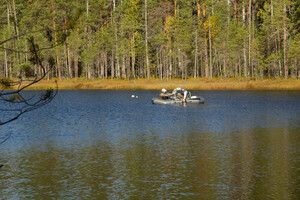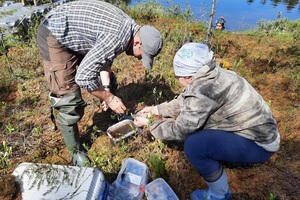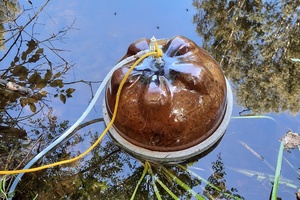Scientists of the Northern Water Problems Institute KarRC RAS told about the first results of research on carbon pools and fluxes in aquatic ecosystems of Karelia. The work is done for the tasks of the RITM Carbon Consortium on creating the Russian Climate Monitoring System (within a federal Key Innovative Project). Last year, research was conducted at three waterbodies in the Kivach Nature Reserve: a small forest lake Chudesnaya Lamba, the Sandalka River, the Chechkin Brook, and in their catchments. Scientists conducted meteorological observations, landscape survey, studied groundwater, hydrological, hydrophysical, hydrochemical, hydrobiological characteristics of water and bottom sediments, as well as developed techniques for monitoring greenhouse gas fluxes at the water-sediment and water-atmosphere interfaces.
The data were presented at the 8th All-Russian Scientific Conference “Hydrometeorology and Ecology 2024” by NWPI KarRC RAS leading scientists Natalya Belkina and Natalia Kalinkina.
Natalya Belkina, Head of the Sediment Research Group at NWPI KarRC RAS, spoke about the results of quantifying major carbon pools in water and sediments, greenhouse gas emissions from sediments to water and from water to air, as well as carbon outflow from the test site with river flow.
The outflow of total carbon from the catchment area of the model watercourses (Chechkin Brook, Sandalka River) peaks during the spring high-water period and decreases during the summer low-water period. The maximum value of specific outflow was recorded in the Sandalka River at the end of April (7.8 t/day), dropping to nearly zero in the summer low-water period (0.03 t/day) due to the decrease in water discharge to 0.01 m3/s.
– We determined the dynamics of the content of various forms of carbon in Lake Chudesnaya Lamba. Existing in a humid climate, the lakelet accumulates organic matter. The highest CO2 emission from sediment to water was recorded during the ice-covered period in April, and amounting to 110 mg/m2 per day, - said Natalya Belkina.
Natalia Kalinkina, Head of the Hydrobiology Laboratory at NWPI KarRC RAS, told about the contribution of plankton in Lake Chudesnaya Lamba to the formation of carbon dioxide fluxes.
– In small endorheic basins (having no outlets), which occupy most of Karelia's paludal territories, CO2 concentration depends mainly on the ratio of photosynthesis and respiration of the biota. To calculate carbon dioxide fluxes in the ecosystem, we customized the balance model of matter and energy fluxes. The results of the studies proved plankton metabolism was heterotrophic, with respiration exceeding photosynthesis by 30%. The contribution of plankton to carbon dioxide fluxes from the water surface of Lake Chudesnaya Lamba was 20-60% depending on the methods of calculating CO2 emissions, – noted Natalia Kalinkina.
The successful experience of model customization for different environmental conditions will enable its application for estimating matter and energy fluxes in waterbodies of different types in Karelia, which can play a significant role in CO2 emission into the atmosphere.
Also, the first year of activities resulted in the registration of the database “The thermo-hydrodynamic and gas regimes of waterbodies in the Kivach carbon testing site”, which includes measured data for current velocities and directions, water temperature and dissolved oxygen and CO2 concentrations. The database structure allows constructing various queries to analyze seasonal and daily variations in water temperature, current velocities and directions, and gas concentrations in water.
Note that Karelia is one of the five pioneer regions, along with Moscow, Siberia and the Far East, where unified methodological approaches are being worked out, which can later be disseminated to waterbodies in other regions of the Russian Federation.
News
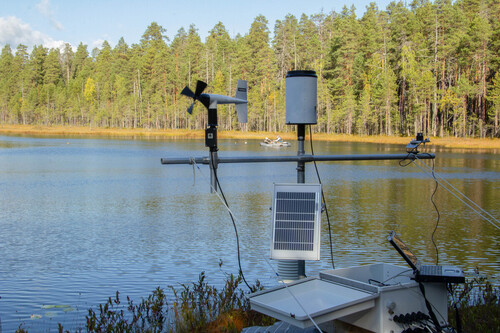
January 13, 2025
Scientists presented the first results of a study on carbon pools and fluxes in aquatic ecosystems of Karelia
A model of carbon emission by waterbodies was created by staff of the Northern Water Problems Institute (NWPI) KarRC RAS after their first year of working within the RITM Carbon scientific consortium. In 2024, Karelia became one of the five regions where unified methodological approaches to estimating greenhouse gas pools and emissions from waterbodies are being developed. In the future, this experience may be disseminated across the country.
A model of carbon emission by waterbodies was created by staff of the Northern Water Problems Institute (NWPI) KarRC RAS after their first year of working within the RITM Carbon scientific consortium. In 2024, Karelia became one of the five regions where unified methodological approaches to estimating greenhouse gas pools and emissions from waterbodies are being developed. In the future, this experience may be disseminated across the country.
See also:
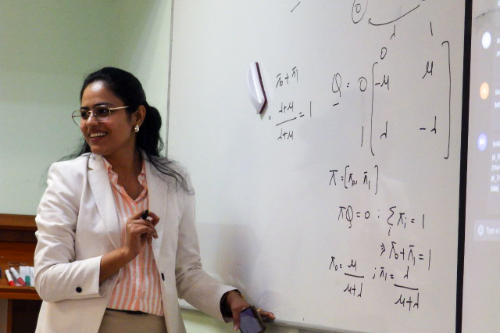
June 5, 2025
Scientists from India and Russia lecture on mathematical modeling of communication systems at IAMR KarRC RAS
Institute of Applied Mathematical Research KarRC RAS is hosting a set of lectures of stochastic modeling of telecommunication systems. Scholars from the Indian Institute of Technology Delhi (IIT-Delhi) are appearing before young scientists from Russia and India as invited professors.
Institute of Applied Mathematical Research KarRC RAS is hosting a set of lectures of stochastic modeling of telecommunication systems. Scholars from the Indian Institute of Technology Delhi (IIT-Delhi) are appearing before young scientists from Russia and India as invited professors.
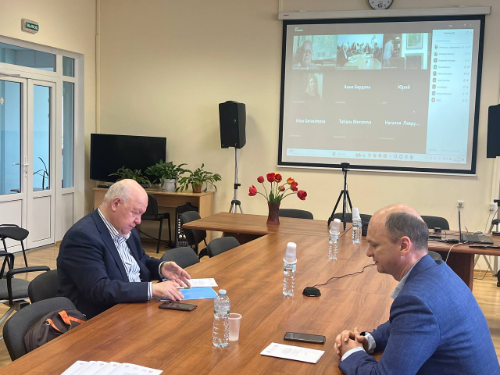
May 30, 2025
Russian scientists discussed the prospects for socio-economic development of border regions at a conference hosted by the Institute of Economics KarRC RAS
All-Russian Science-to-Practice Conference “Prospects for Socio-Economic Development of Border Regions” is taking place on May 29-30 at the Institute of Economics KarRC RAS. It is held at the Institute biennially and has become a traditional regional venue for the Moscow Academic Economic Forum to discuss theoretical and practical perspective of the development of border areas. This year's conference, already the ninth in the series, is also dedicated to the 80th anniversary of the Victory in the Great Patriotic War.
All-Russian Science-to-Practice Conference “Prospects for Socio-Economic Development of Border Regions” is taking place on May 29-30 at the Institute of Economics KarRC RAS. It is held at the Institute biennially and has become a traditional regional venue for the Moscow Academic Economic Forum to discuss theoretical and practical perspective of the development of border areas. This year's conference, already the ninth in the series, is also dedicated to the 80th anniversary of the Victory in the Great Patriotic War.
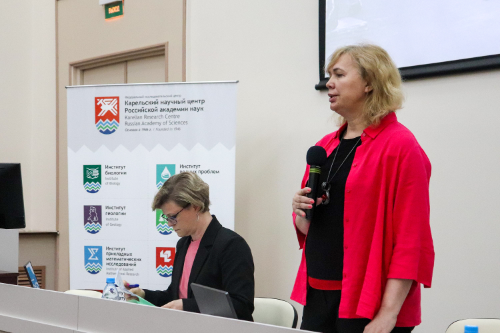
May 26, 2025
Election Campaign for the Director General of KarRC RAS Officially Begins
The Russian Ministry of Science and Higher Education has approved the candidates for the position of Director General of the Karelian Research Centre RAS, previously nominated by KarRC RAS Learned Council. The candidates are the current acting Director General Olga Bakhmet, Deputy Director General Yuri Zaika, and Director of the Forest Research Institute KarRC RAS Alexander Kryshen. At an extraordinary meeting on 26 May, KarRC RAS Learned Council approved the composition of the electoral commission, which will organize the election process.
The Russian Ministry of Science and Higher Education has approved the candidates for the position of Director General of the Karelian Research Centre RAS, previously nominated by KarRC RAS Learned Council. The candidates are the current acting Director General Olga Bakhmet, Deputy Director General Yuri Zaika, and Director of the Forest Research Institute KarRC RAS Alexander Kryshen. At an extraordinary meeting on 26 May, KarRC RAS Learned Council approved the composition of the electoral commission, which will organize the election process.




